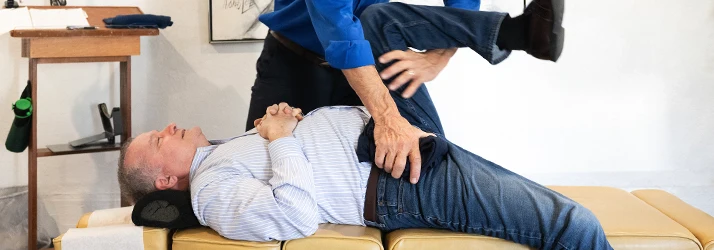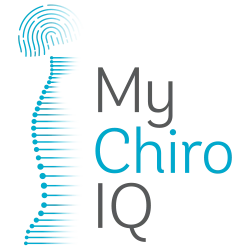Hip Pain in Mt Pleasant SC?

The hip joints are some of the most mobile and frequently used joints in the body. They are also a frequent site of injury and pain for many people we see in our Mt Pleasant SC chiropractic clinic. Check out the most common hip conditions and treatment options.
Hip Bursitis in Mt Pleasant SC
Bursas are fluid filled sacs located throughout the body and are responsible for providing lubrication between muscles and skin. Typically through impact or repetitive movements, a bursa will become inflamed and will be very tender to the touch.
Bursitis tends to be characterized as pinpoint pain that is dull or achy at rest and sharp during aggravating movements or when there is pressure over the bursa. Hip bursitis is typically characterized as having pain over the outside of your hip. Pain while laying on your side is very common. Bursitis responds well to manual techniques and application of modalities as well as fixing movement faults to reduce the overall amount of stress placed on the inflamed bursa.
Bursitis tends to respond well to passive treatments such as corticosteroids shots to reduce inflammation in conjunction with active treatments.
Hip Tendonitis
General hip tendonitis is characterized as having swelling of the tissues (tendons) connecting muscle to the bone in the hip joint.
Hip tendinitis is typically caused by repetitive overuse or stress of the tendons, such as from running or working out. Symptoms include pain that feels like a dull ache, and stiffness. Pain is increased when performing the aggravating activity.
Hip Labral Tear
A hip labral tear involves the ring of cartilage that follows the outside rim of your hip joint. The hip joint is a ball and socket joint and the labrums responsibility is to not only provide cushion and shock absorption during walking, running, and landing but also to deepen the socket to provide stability of the hip joint.
A hip labral tear is characterized as deep hip pain or pain that radiates to the glute or into the groin. It is often reflected on as C-sign hip pain. Hip labral tears do not always require surgery in a normal adult population but are more common for people who are still involved in sport activities.
Physical therapy and acupuncture to improve hip strength, muscular imbalances, and to improve balance are important for pre-operative hip labral tears. Physical therapy protocols are involved for post-operative care based on the type of surgery performed.
Hip Arthritis
Hip arthritis is one of the most common causes of pain in the hip. It is a progressive disorder, which means that it typically starts gradually and gets worse with time. In the beginning stages of arthritis pain may be minimal but as it progresses pain will increase, become more severe, and begin limiting function of the hip.
Hip arthritis is aggravated by progressing age, hip dysplasia, previous hip injury, or obesity placing increased stress to the hip. Prolonged sitting or standing tends to increase pain with hip arthritis and is improved through movement such as walking.
Improving strength, improving hip mobility, and losing weight are important to reduce the pain associated with hip arthritis.
Impingement Syndrome
Hip impingement, also known as femoroacetabular impingement (FAI), is a condition in which there is abnormal and wearing contact between the ball and socket of the hip joint. The result is increased friction during hip movements that may damage the joint.
With hip impingement syndrome, there tends to be a rubbing on the tendons, muscles, ligaments, cartilage, labrum, or bones of the hip causing pain. Impingement syndrome is aggravated based on position and pain is common in sitting or with leg crossing.
Successfully reducing pain with hip impingement syndrome is reliant on determining what is being impinged. In general, pain is alleviated by reducing muscle imbalances and reducing inflammation through various exercises, modalities, and manual treatments.
Snapping Hip and Popping Hip
Snapping and popping hip are often interchanged but are two different issues:
- Snapping hip is a popping sensation located at the front of the hip. This will feel like a deep groin pop and happens during activities such as leg lifts or when kicking a soccer ball. It is associated with tightness with the iliopsoas muscle and can be improved or alleviated with manual release of the muscle and keeping up with a consistent stretching protocol.
- Popping hip is located at the outside portion of the hip. It is common to feel consistent popping during running activities. Popping hip is typically associated with tightness with the ITBand. The ITBand is a thick band of tissue and is difficulty to stretch but responds well to manual treatments such as cupping or rolling out.
Hip Fractures
A hip fracture is a fracture of the femur, which is the strongest bone in the body. A hip fracture in young adults or kids is usually as a result of intense trauma or falls and in older adults or the elderly is associated with a fall or a diagnosis of osteopenia or osteoporosis.
Hip fracture may require surgery depending on the severity of the injury. Following surgery, physical therapy is important to regain strength and mobility and is important to improve balance and proprioception to reduce the risk of further falls. Additional assistive device training may be important to improve balance.
Hip Muscle Strains or Pulled Muscle
A muscle pull of the hip happens when a muscle of the hip is stressed or stretched beyond its limit. This can be during an explosive activity such as running or kicking or an intense moment of stretching.
Common muscle strains or pulls in the hip are the hip flexors, the glutes, the quads, or the hamstring muscles. Reducing inflammation of the muscle strain and alloying the muscle to rest and heal is important to reduce re-injury or further injury of the muscles.
Following healing of the muscle, further neuromuscular re-education, strengthening, and stretching is important to regain stability and resilience of the muscle.
What To Do Next…
If you’re currently experiencing hip pain, My Chiro iQ Chiropractic welcomes you for a complimentary consultation with Dr. Ross to determine if chiropractic care is right for you. After an examination, he can provide an individualized approach to the root of the problem.
Call for your appointment today! (843) 766-4444
OFFICE HOURS
Monday
1:00pm - 6:00pm
Tuesday
8:00am - 5:00pm
Wednesday
8:00am - 5:00pm
Thursday
8:00am - 5:00pm
Friday
Closed
Saturday & Sunday
Closed
My Chiro iQ
419 Hibben St
Mt Pleasant, SC 29464



